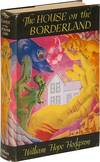![The Spectrum of the Radium Emanation" [in] Proceedings of the Royal Society, volume LXXIII, No. 495.](https://d3525k1ryd2155.cloudfront.net/h/630/044/1533044630.0.m.jpg)
The Spectrum of the Radium Emanation" [in] Proceedings of the Royal Society, volume LXXIII, No. 495.
by Ramsay, William & J. Norman Collie
- Used
- first
- Condition
- See description
- Seller
-
Moray, United Kingdom
Payment Methods Accepted
About This Item
London: Harrison and Sons & R. Friedländer & Sohn for the Royal Society, June 22, 1904. Octavo. Original grey-green wrappers printed in black. 2 folding graphs. Index leaves on onion skin paper loosely inserted. Contents partially unopened, leaf 2K7 clumsily opened with slight loss from the margin. Wrappers toned along the spine and edges, a little rubbing and some nicks and creases along the edges, slight loss from the head of the spine. Very good condition. First edition, the journal issue in original wrappers. Chemist Sir William Ramsay's (1852-1916) most important research was on the noble, or inert, gases. He was the first to isolate helium and discovered neon, krypton, xenon, and argon, the latter being the element for which he and John William Strutt, 3rd Baron Rayleigh, were awarded Nobel Prizes in 1905. In his Nobel lecture Ramsay described on-going spectroscopic work on radium, begun in 1903: "Much work remains to be done on these emanations. In conjunction with Dr. Collie, my colleague, the spectrum of the radium emanation has been mapped. It resembles generally speaking those of the inert gases... It might then be an unstable member of the argon family; there is a vacant place for an element with atomic weight about 162". Ramsay's work with radium was not particularly fruitful, and this paper mainly deals with efforts to purify samples and obtain accurate readings.
Reviews
(Log in or Create an Account first!)
Details
- Bookseller
- Alembic Rare Books
(GB)
- Bookseller's Inventory #
- 796
- Title
- The Spectrum of the Radium Emanation" [in] Proceedings of the Royal Society, volume LXXIII, No. 495.
- Author
- Ramsay, William & J. Norman Collie
- Book Condition
- Used
- Quantity Available
- 1
- Publisher
- Harrison and Sons & R. Friedländer & Sohn for the Royal Society
- Place of Publication
- London
- Date Published
- June 22, 1904
- Keywords
- Physics|Nuclear Physics
Terms of Sale
Alembic Rare Books
30 day return guarantee, with full refund including original shipping costs for up to 30 days after delivery if an item arrives misdescribed or damaged.
About the Seller
Alembic Rare Books
Biblio member since 2018
Moray
About Alembic Rare Books
We specialise in rare science books dating from the late Middle Ages to the 20th century, including first editions, signed copies, manuscripts, objects, and ephemera. We have particular expertise in natural history, genetics and evolution, anatomy, nuclear physics and the Manhattan Project, early computing, and women in science. We also carry books related to women's history and literature.
Glossary
Some terminology that may be used in this description includes:
- First Edition
- In book collecting, the first edition is the earliest published form of a book. A book may have more than one first edition in...
- Wrappers
- The paper covering on the outside of a paperback. Also see the entry for pictorial wraps, color illustrated coverings for...
- Octavo
- Another of the terms referring to page or book size, octavo refers to a standard printer's sheet folded four times, producing...
- Spine
- The outer portion of a book which covers the actual binding. The spine usually faces outward when a book is placed on a shelf....
- Edges
- The collective of the top, fore and bottom edges of the text block of the book, being that part of the edges of the pages of a...
- Rubbing
- Abrasion or wear to the surface. Usually used in reference to a book's boards or dust-jacket.
- Unopened
- A state in which all or some of the pages of a book have not been separated from the adjacent pages, caused by a traditional...
- Leaves
- Very generally, "leaves" refers to the pages of a book, as in the common phrase, "loose-leaf pages." A leaf is a single sheet...
![The Spectrum of the Radium Emanation" [in] Proceedings of the Royal](https://d3525k1ryd2155.cloudfront.net/h/630/044/1533044630.0.s.jpg)
![The Spectrum of the Radium Emanation" [in] Proceedings of the Royal](https://d3525k1ryd2155.cloudfront.net/h/630/044/1533044630.1.s.jpg)
![The Spectrum of the Radium Emanation" [in] Proceedings of the Royal](https://d3525k1ryd2155.cloudfront.net/h/630/044/1533044630.2.s.jpg)
![The Spectrum of the Radium Emanation" [in] Proceedings of the Royal](https://d3525k1ryd2155.cloudfront.net/h/630/044/1533044630.3.s.jpg)
![The Spectrum of the Radium Emanation" [in] Proceedings of the Royal](https://d3525k1ryd2155.cloudfront.net/h/630/044/1533044630.4.s.jpg)


